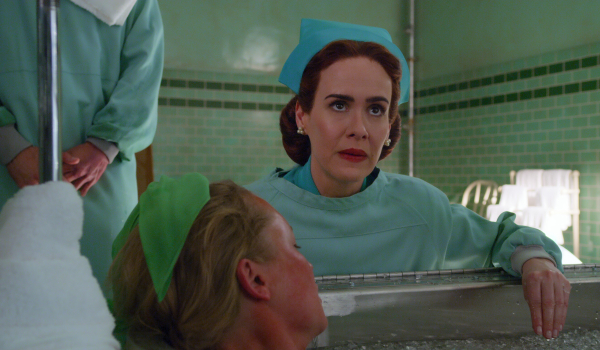
News
Summers Will Not Finish Semester of Teaching as Harvard Investigates Epstein Ties

News
Harvard College Students Report Favoring Divestment from Israel in HUA Survey

News
‘He Should Resign’: Harvard Undergrads Take Hard Line Against Summers Over Epstein Scandal

News
Harvard To Launch New Investigation Into Epstein’s Ties to Summers, Other University Affiliates

News
Harvard Students To Vote on Divestment From Israel in Inaugural HUA Election Survey
Bright Colors Belie a Jarring Thriller in Season One of ‘Ratched’

If Ryan Murphy has one thing, it’s range. From “American Horror Story” to “Glee,” and from “Pose” to “Scream Queens,” the screenwriter and producer has proven time and time again that he can (and will) write any type of story. This continues to ring true in Murphy’s latest venture, the Netflix original psychological thriller series, “Ratched.”
A spinoff series based on the character Nurse Mildred Ratched (the incomporable Sarah Paulson) from “One Flew Over the Cuckoo’s Nest,” “Ratched” takes place in 1947 and opens with a shocking murder sequence in which a young man, Edmund Tolleson (Finn Wittrock), slays a group of priests in their own home. After the brutal killings, Tolleson is apprehended and transported to Lucia State Hospital, a leading psychiatric hospital known for its unorthodox mental health treatments. Although the series opens with Tolleson’s murders, it ultimately follows Mildred Ratched as she manipulates her way into a nursing job at Lucia State and rises to head nurse.
At the hospital, we meet the callous head nurse Betsy Bucket (Judy Davis); the sex-obsessed, ingenue nurse trainnee Dolly (Alice Englert); and the founder and head doctor of Lucia State, Doctor Richard Hanover (Jon Jon Briones). Along with those who work at the hospital, Ratched meets California's sadistic, chauvinist governor George Willburn (Vincent D’Onofrio) who is up for re-election and his campaign manager Gwendolyn Briggs (Cynthia Nixon). Each of these characters plays a role in Ratched’s life as she juggles her new job, coming to terms with her homosexuality, falling in love with a woman, and hiding a damning secret that both explains and threatens her position at Lucia State.
Fans of Paulson and Murphy know that this pairing isn’t unfamiliar. Paulson has starred in both “American Horror Story” and “American Crime Story“ and the pair’s close working relationship is evident in the seamless fit between writing and performance. No one other than Paulson could have acted this role the way Murphy wrote it.
From sharing heartfelt moments with her lover to convincing a patient at the hospital to end his life, Mildred Ratched is a complex character — the ultimate anti-hero. The combination of Murphy’s masterful writing and Paulson’s precise yet nuanced acting leaves viewers unsure as to whether they should be rooting for Ratched’s success or her demise.
Another remarkable feat of “Ratched” is its visual appeal. For a show that takes place primarily in an asylum, “Ratched” has surprisingly warm visuals — rife with bright, saturated colors akin to those used in more heartfelt, happy shows and reminiscent of the colorful ballroom scenes in “Pose.” Details such as the nurses’ teal-blue uniforms, white fluorescent lights of the hospital, and grandiose shots of the green California coastline create a sense of lightheartedness, as if its creators were trying to make the audience forget that the show is a thriller.
Not even the beautiful colors or Ratched’s stylish 1940s fashion can distract from just how gory “Ratched” is. The horrific murder sequence in which Tolleson kills the group of priests is immediately followed by a shot of the bright blue Pacific Ocean. A scene in which Doctor Hanover performs an icepick lobotomy takes place in a well-lit white room populated by the nurses in their blue uniforms. It is this juxtaposition of bright colors and — quite frankly, gratuitous — violence that makes “Ratched” even more jarring for viewers. At times this contrast works in the favor of the show, making scary scenes more shocking than they otherwise would have been. At others, it is tonally confusing and more distracting than anything else.
The story also does not unfold smoothly. “Ratched” has many intertwining yet distinct subplots, which at times, becomes confusing and overwhelming. While these varying story lines do eventually resolve, getting there is taxing. Many of the supporting characters have their stories told through these subplots, but sadly, most of them do not get the ending they deserve. The likable characters just end up dead and the evil ones evade prosecution.
Another wrinkle in the fabric of the plot is Nurse Ratched’s backstory. The backstory itself is not the issue; in fact, it provides much-needed exposition into the character’s life and why she is as complex as she is. The issue is its timing. By the time viewers finally get a glimpse into Ratched’s dark, twisted past, they are already six episodes into the eight-episode season and are left with more questions (arisen from the many subplots) than the backstory answers.
Despite its pitfalls, “Ratched” has an undeniable charm. Even with the gratuitous violence, confusing subplots, and questionable time management, the episodes of “Ratched” move at a steady, upbeat pace, making its eight installments bingeable. Murphy’s storytelling and Paulson’s acting transport viewers to a surreal 1940s dreamscape (or nightmare-scape, rather), making the show the perfect, sick, twisted, escapist fantasy. Its ending strategically sets the series up for a second season, one that viewers are bound to anticipate after getting caught up in the life of Nurse Mildred Ratched.
— Staff writer Annie Harrigan can be reached at annie.harrigan@thecrimson.com.
Want to keep up with breaking news? Subscribe to our email newsletter.
